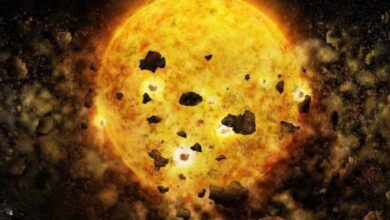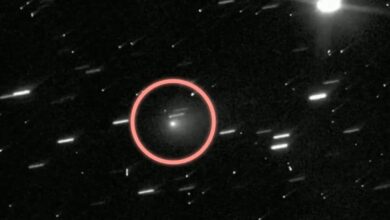Hubble Finds Multi-Age Stars, Galaxy Origins Rewritten

Hubble’s Discovery: Multi-Age Stars in Ancient Cluster
The Hubble Space Telescope has provided astronomers with a groundbreaking new image of the ancient star cluster NGC 1786. Located 160,000 light-years away in the Large Magellanic Cloud, this dense cluster was previously believed to contain stars of a single generation. However, Hubble’s data reveals a surprising mix of stellar ages, challenging existing theories about galaxy formation.
NGC 1786: A Galactic Time Capsule
NGC 1786, often referred to as a “time capsule,” offers a glimpse into the early history of its host galaxy. These globular clusters are densely packed with stars and are thought to preserve some of the oldest stars in a galaxy. The new Hubble image, part of a program comparing ancient clusters in nearby dwarf galaxies with those in the Milky Way, has overturned previous assumptions about the uniformity of these clusters.
The discovery of multiple stellar generations within NGC 1786 suggests a more complex and layered history than previously anticipated. This finding prompts a re-evaluation of how galaxies, including our own Milky Way, assembled their first stars.
Implications for Galaxy Evolution
The presence of mixed-age stars in NGC 1786 has significant implications for our understanding of galaxy evolution. It suggests that the Large Magellanic Cloud, and potentially other galaxies, built their stars in stages rather than in a single, rapid burst of star formation. This gradual growth model is further supported by comparisons between NGC 1786 and similar clusters in the Milky Way.
Understanding Early Star Formation
By studying these ancient clusters, astronomers can piece together the processes that shaped the earliest generations of stars. The discovery of multiple stellar populations within NGC 1786 provides valuable insights into the conditions and mechanisms that governed star formation in the early universe.
- Key Finding: NGC 1786 contains stars of different ages.
- Implication: Galaxies may have formed stars in stages.
- Significance: Reshapes our understanding of galaxy origins.
Comparing with the Milky Way
Comparing NGC 1786 to globular clusters within the Milky Way allows researchers to trace the similarities and differences in the formation histories of these galaxies. This comparative approach helps to refine our understanding of the universal processes that govern galaxy evolution.
| Feature | NGC 1786 (LMC) | Milky Way Clusters | Significance |
|---|---|---|---|
| Stellar Age | Mixed | Potentially Mixed | Challenges single-generation theory |
| Location | LMC | Milky Way | Comparative study of galaxy evolution |
| Density | High | High | Typical of globular clusters |
Future Research Directions
Further research is needed to fully understand the implications of this discovery. Astronomers plan to conduct more detailed studies of NGC 1786 and other similar clusters to determine the prevalence of multiple stellar generations and to further refine our models of galaxy formation.
Unresolved Questions
- What specific events triggered the different episodes of star formation within NGC 1786?
- How common are mixed-age populations in other globular clusters?
- What role did mergers and interactions play in the formation of these clusters?
By addressing these questions, astronomers hope to gain a more complete picture of the complex processes that shaped the galaxies we see today.




